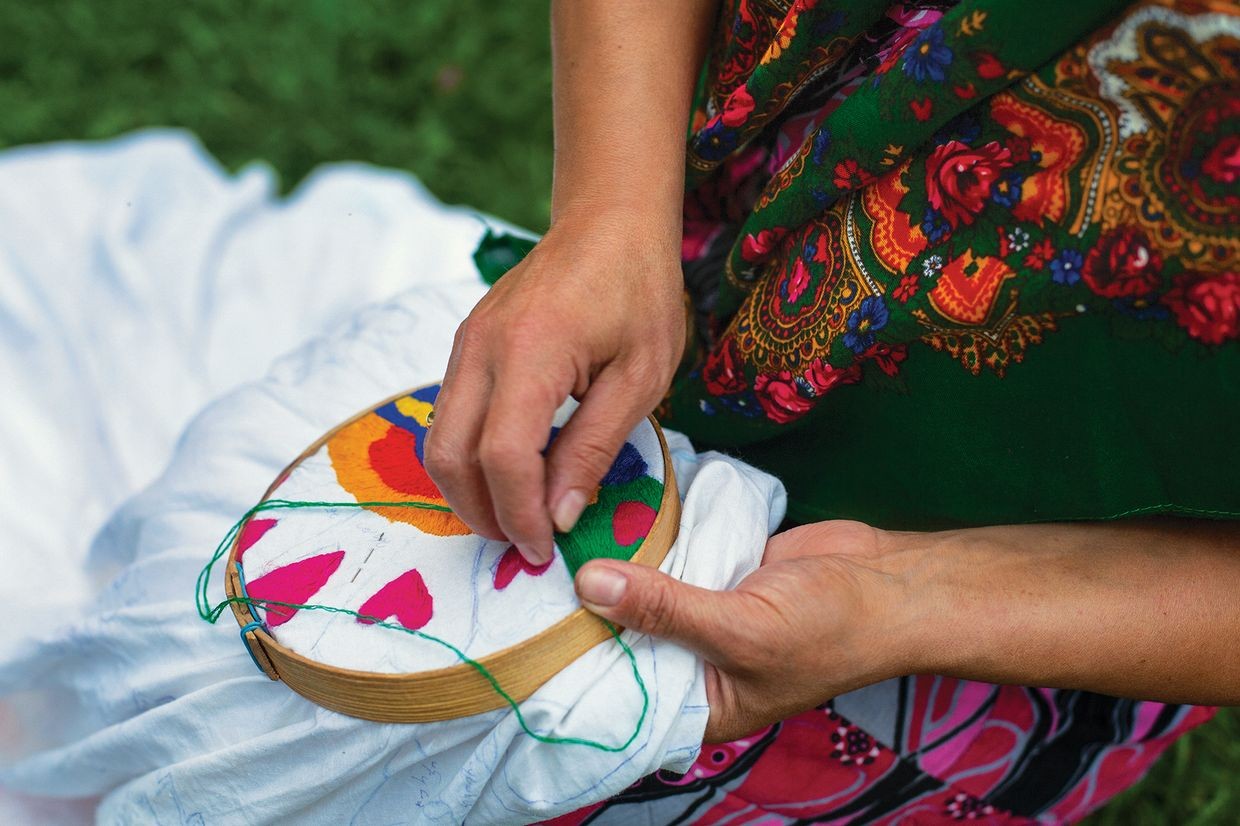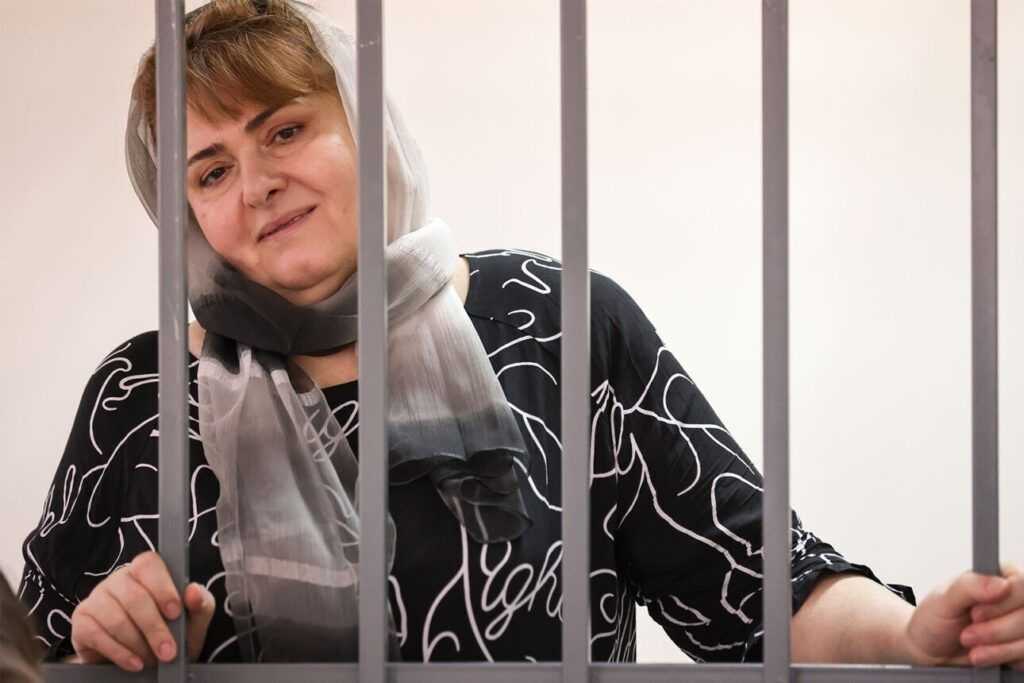
Irma Sharikadze’s exhibition, consisting of cloth, film, and sculpture, showcases the rich but endangered Adjarian tradition of embroidery.
On 18 May, International Museum Day, Tbilisi’s State Silk Museum filled its ground-floor temporary exhibition rooms with the combined labours of Georgian multimedia artist Irma Sharikadze, and a group of women from the southwesterly region of Georgia, Adjara.
Adjara lies at the foot of the Lesser Caucasus mountains, bordering Turkey to the south and the Black Sea to the west. Most of the women featured in the exhibition live in villages dotted around Adjarian highlands: Photaro, Ozurgeti, Ghorjomi, Janivri.
Projected in the back room of the exhibition is a film providing context to the works featured. It is here that the visitor is introduced to Shakiradze, who sits on an embroidered bedspread. With her long black hair, her bright patterned dress, and her aquiline nose, she looks herself like some kind of mythical motif.

Shakiradze tells the viewer that she’s been researching Adjarian embroidery since 2019, and is determined to help preserve this flagging tradition.
In between extraordinary drone shots of the Adjarian mountains, we meet the women she worked with, all over 50 years old. They have arranged their numerous works of embroidery around them, and are dressed in embroidered shirts and headdresses, resulting in a magnificent moving tableaux of colours and symbols. The women sit pride of place, their hands fiddling with invisible thread, their gold teeth winking.

The audience is told that in Adjara, embroidery was traditionally an important part of a bride’s dowry. Young girls would make their trousseau with their own hands, and there was a good deal of competition in a given village between brides to have the grandest and largest array. A self-respecting bride, Shakiradze tells us, would enter into an engagement with 20–30 works.
Yet today, this tradition is under threat. As one woman explains in the video, ‘life is more comfortable nowadays’ — women in the highland villages now simply buy their stockings and spreads. The dowry culture has evaporated, and young women no longer pass their time with a needle and thread. Judging by the testimonies of the women, there is now a certain eccentricity to pursuing this tradition. Patterns are preserved, we are told, by tracing the outline of old damaged pieces of embroidery for reproduction.

The first room features a set of gorgeous large-scale photographs of the women, at work in their homes or gardens. Shakiradze titled the installation ‘Flower Power’. As you might discern from that name, Shakiradze brings a kind of millennial girlishness to the centuries-old Adjarian tradition.
The actual designs on exhibition, all hand-stitched on cotton or silk, feature floral and geometric motifs alongside animal, mythological, and anthropomorphic figures. Some symbols, like the Tree of Life and its guardians, are associated with archaic fertility cults. Mermaids recur, as do peacocks, maidens, horses, and flowers. Some colour schemes look more organic and muted; others, though no less beautiful, are artificially bright, run through with a plasticky gold.

There are also a couple of ceramic works by Sharikadze, including a charming ceramic mermaid with a multicoloured tail, and an anatomically correct heart emblazoned with a rose.
The ‘Kheberi’ in the exhibition title means ‘story’ in the Adjarian dialect. The film itself, the array of embroidered works, and Shakiradze’s modern interpretations of Adjarian decorative motifs, all combine to draw a throughline, a narrative, from the ancient female tradition to its modern iterations. Regrettably, however, the nature of the collaboration between Sharikadze and these women is never quite defined. I was curious to understand the extent of Shakiradze’s artistic direction; the places where she guided the women out of the traditional and into the contemporary. Unless you are very familiar with Adjarian embroidery patterning, it is hard to identify departures from tradition. The embroidered balloon-sleeved boho-style dress from Shakiradze’s fashion line is the only self-evident example of the melding of old and new.

Tbilisi’s State Silk Museum is located in an airy, classical building, designed by the Polish architect Aleksander Szymkiewicz in 1887. Szymkiewicz was a prime mover in 19th century Georgian architecture; he is also responsible for Georgia’s Supreme Court building, the Conservatoire, Rustaveli Theatre, and a scattering of elegant townhouses around the city.
Besides the temporary exhibitions, such as Sharikadze’s, the museum keeps a lovely permanent collection upstairs of all things silk: looms, materials from all over the world, brilliant 1950s posters on silk production, jars and jars of natural dyes, preserved silkworms, cocoons, and mulberry leaves, and funny miniature models of women spinning and sewing.
The Embroidered Kheberi: Adjarian Women’s Heritage — Between Myth and Contemporary is open at the Tbilisi Silk Museum until 28 June. The embroidered works, the photographs, and the film are all truly gorgeous, while the Silk Museum’s permanent collection is also well worth a visit.
🗞️ Subscribe to the OC Culture Dispatch
For our culturally curious readers: a free, biweekly selection of film, book, and music recommendations from the Caucasus. Our team offers a varied selection of hidden gems, cherished classics, and notable new releases from all over the region, included in our newsletter.









